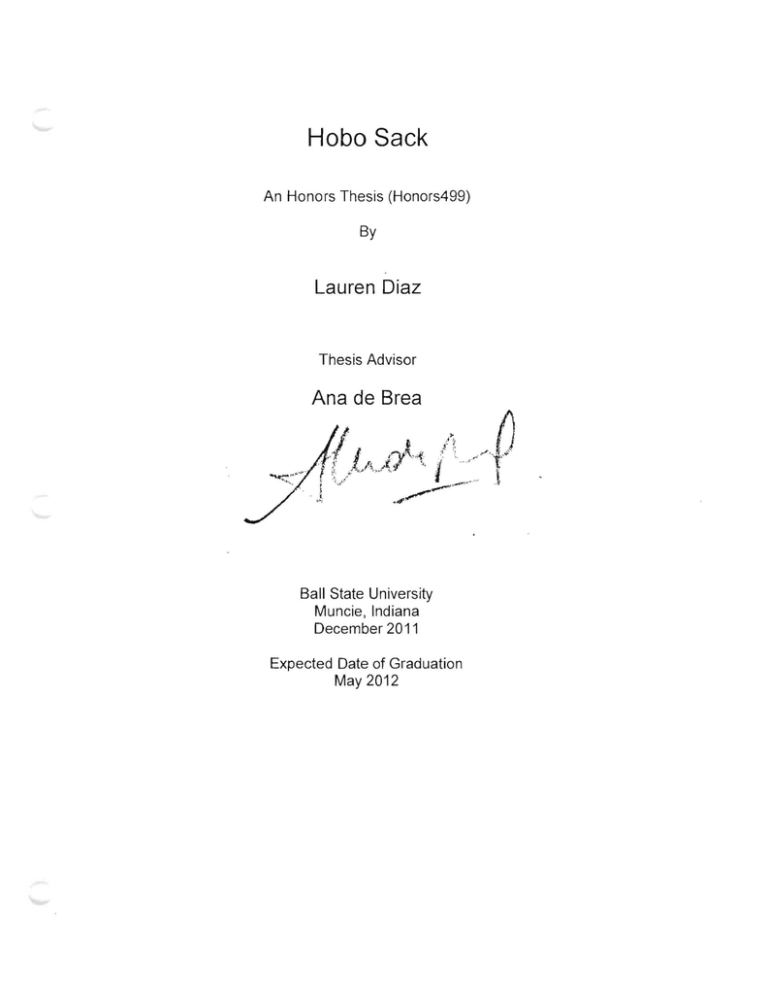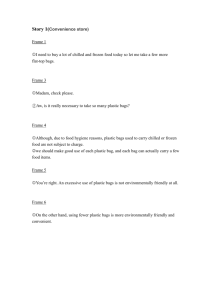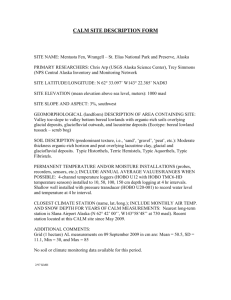Hobo Sack Lauren Diaz
advertisement

Hobo Sack An Honors Thesis (Honors499) By Lauren Diaz Thesis Advisor Ball State University Muncie, Indiana December 2011 Expected Date of Graduation May 2012 Abstract Homelessness is a global issue affecting thousands of lives a year. Through my travels to South America and working in Los Angeles this past summer, I witnessed an unprecedented number of men and women sleeping on the ground, on benches, or even on buses. I created and built at full scale an alternative, temporary sleeping shelter for the homeless, which is beautiful, personal, and restores dignity to the user by getting them off of the ground. I researched previous attempts at similar solutions and created my own building material for this project. After many tests with plastic bags, I created a sleeping structure made almost completely from found objects. Acknowledgements I would like to thanks Ana de Brea for advising me through this project. Her help and creativity were inspirational. I would also like to thank everyone who donated plastic bags for my project, there are too many to list here. Also, Katie Harms for the use of her iron. Finally, I would like to thank my twin sister, Ellery Diaz, for being the first to test the Hobo Sack. Author's Statement The Hobo Sack aims to offer alternative and temporary shelter, use sustainable materials and methods, as well as begin to repair the social connotations of "tent cities." The Hobo Sack would be used to sleep in or to protect an individual from rain or snow. I gathered precedence for this project from looking at various designers and social rights activists. I looked at Ore Wapenaar who creates beautiful tents. Their rib cage construction was inspirational and seemed very successful, but expensive (Wapenaar.) Ernesto Neto's installations are ethereal and encompass the idea of comfort I was looking to achieve (Neto). The "Red Tents" campaign in France showed me how others have taken stances against homeless ness. They indicate the high homelessness rate by placing red tents around the country (Red). As well, the EDGAR shopping carts/ sleeping unit was one of the most successful attempts at creating temporary sleeping structures I have seen. However, many have been stolen from one another since they are expensive to build (Edgar). All of these influences, both aesthetically and socially, helped me develop a beautiful, light weight, and inexpensive shelter. The construction of this temporary shelter is be made from reclaimed plastic bags and rope. Four to five layers of ironed flat plastic shopping bags were ironed together with a regular hand iron using a piece of trace paper in-between to protect the iron. The ironing took approximately twenty hours, not including the time it took to prepare the bags. I trim med the edges of the ironed bags to create a six and a half diameter circle. I hand sewed a water resistant, high stress yielding rope with a secondary wire to the fabric of bags. This rope is used for the structural system of the Hobo Sack. A ventilation system could be incorporated for a Hobo Sack to be used in hot climates. Using the CNC mill with a "fabric bit" would allow me to add subtle scallops to the plastic sheets to allow cross ventilation through the Hobo Sack. The construction was pretty minimal for the Hobo Sack and could easily be repeated. As well, homeless persons requiring the tent could be responsible for collecting all of the plastic bags for the sleeping unit in order to have an active role in the creation of the unit. This would also promote sustainability by re-using commonly disposed materials. The plastic bags, when ironed together like a patchwork quilt, have a very high stress yield in tension. The five layers of plastic bags and rope would be gathered at the top and hung from a tree branch or similar hanging unit. If none such hanging opportunity can be found, a secondary wooden structure could be constructed and carried with the tent. To increase the functionality of the Hobo Sack, I wanted to make it easily transportable and light. The Hobo Sack aims to return a homeless person's dignity by getting them off the ground. It uses a comfortable hammock/womb-like system to cradle a sleeping " '7 / person , The Hobo Sacks, when seen individually or in a collection, would be seen as a beautiful way to address "tent cities," These temporary shelters could be multicolored or change shape depending on how many people the Hobo Sack could accommodate, The name Hobo Sack is used to add a little humor and lighten the situation of curing homeless ness. Hopefully by seeing a thoughtful use of materials and unique shape, this would discourage people form immediately dislike seeing a new take on a "tent city." The Hobo Sack is by no means a way to end homelessness or completely change people's minds against "tent cities." It would just scratch the surface at correcting the negative connotations of homelessness . The Hobo Sack would also help promote responsibility and resourcefulness among users of the unit. It would require users to scour areas for used bags to have an active role in constructing a successful unit. The Hobo Sack would also promote sustainability through the repurposing of plastic shopping bags. This project also aimed to innovatively create a new building material, which could be cheap, accessible, and strong against rain and wind , The Hobo Sack would protect the homeless from harsh weather and offer a comfortable, hanging apparatus to re-energize them for a new day. t Works Cited Edgar. "Housing and Shelter." Sept 13 2011. <http://www.shelterlistings.org/city/edgar-ne.html > Neto, Ernesto. "Ernesto Neto CMOA" Aug 15 2011 . http://www.cmoa.org/international/html/art/neto.htm Red Tents. "Red Tents in Paris." Nov 032011. <http://redtents.org/about/redtents-in-paris> Wapenaar, Ore. "Studio Ore Wapenaar." Sept 20 201lo <http://www.drewapenaar.nlj> l:_-. I / waned u0!lel!lUall alq!ssod -5 ~)es oqoH :fo ueld -v dOl uo UMas walsAs lempnJ1S -t pawwPl pue apJP e OlU! pade4s s6eq paUOJI -l leu PWI pue uado lnJ s6eq )!lSeld :fO spaJPunH - L ,5"9 \ \ \ \ ( \ I \ \ \ \ \ -- - - - \ \ " " .. \'\"\'' "1 i ~' .. ':1&.: ". ail of structural system uetail of plastic bag "fabric" 8- Finished product hanging in studio 1- 9-11-- Person getting inside of the Hobo Sack 12- Comfortably sleeping inside, warm and dry ~w from inside the HoboSack with the flap open






